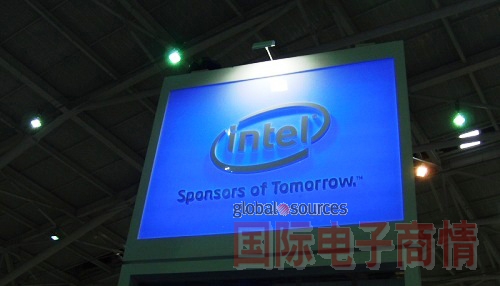
关键字:台北国际计算机展
在我眼中,Computex已经来到了最后阶段──并不是指今年是最后一年,而是以其历史来看,尽管这个展会仍然年年成功,还是会走向终点;就像曾经盛极一 时的美国COMDEX展会,总有一天Computex也会黯然失色。而在今年的展会上已经有一些迹象显示,Computex的退场时间只会更早不会更晚。

南港展览馆外的艺术雕塑
也许是台湾的PC产业正在努力应对来自智能手机、平板装置与其它行动产品的破坏性冲击,在今年的Computex展场上看不到什么与众不同或是具颠覆性的新玩意儿──这些日子以来,产业界较具颠覆性的技术趋势都发生在软件领域。
台湾ODM厂商目前面临的挑战,在于为其实已经诞生四年的Ultrabook机型带来具竞争力的价值;而无论 Windows 8 上不上市(或是会不会“发”),该平台可将消费者的心从手持式装置那边拉回来,是种太夸大的说法。
无论如何,来到Computex的第一天还是很令人兴奋。

人来人往的 Computex展会现场
华硕(Asus)与英特尔(Intel)摊位上的标语,还是展现了产业界推出革命性产品的承诺。
华硕的标语看来与该公司向来致力产品差异化的策略一致,但英特尔的标语其实应该改成“昨日的赞助者(sponsors of yesterday)”──这家公司毕竟主导运算世界数十年咩…不管怎样,以上两句对英特尔来说都有激励作用。如果制造尺寸最小、速度最快的处理器是成功 关键,就像英特尔不断重复创造的成就,就算该公司不再主导市场,那一样至关重要。

华硕摊位的广告标语

英特尔摊位的广告标语
说到明天,英特尔显然借着Thunderbolt技术吸引不少产业界的关注。

英特尔力推Thunderbolt规格
但我的意思可能会让人误解…Thunderbolt传输线的价格是USB传输线的二十倍,还没将主机端与接收端所需采用的特殊英特尔芯片;因此该技术要让消费者获得比传输速度加倍更多的好处才行。不过,速度这个卖点还是不错。
至于华硕,该公司似乎颇为成功地拉开与对手之间的差距;从其最新款的“变形平板”系列产品可看出一二。除了挑战平板装置的外观设计,华硕想表达的理念像是在说:为何不把传统的PC功能以及触控、可携式、视觉运算等…整合在同一个解决方案中呢?

华硕展出最新变形平板系列产品
游戏产业在整个PC市场的贡献度有多少?从Computex展场的游戏相关厂商占据规模,让人相信该比例可能高达25%。从一款标榜超级散热效果的机壳,到价值1,000美元的绘图卡,这种感觉要着火了的热度,在游戏产业领域都是很平常的事情。

热力四射的游戏产业
而令人惊讶的是,今年是中国传统的龙年,但在Computex展场上看不到太多对于此象征性文化符号的着墨。对中国龙年形象的最佳诠释奖或许可颁发给精英计算机(ECS),该公司将在摊位上将龙形图案与其锁定游戏玩家的高运算性能产品做了结合。

精英计算机摊位上的中国龙形设计
最后,笔者要为前面所说的,Computex将退场的预测向展会的主办单位致歉;但是,如果主事者继续让很容易从其它来源取得的产品充斥展览会场,我所预言的事情恐怕很快就会成真。事实上,在Computex期间实际的产业交流活动,都是在展场附近饭店内的私人展示间里进行,因此展场上的那些产品越来越无关紧要,想看的话去大卖场就有了。
但如果没有了Computex,你恐怕会错失造访台湾的机会;在那块土地上,施振荣等电子产业先驱,曾思索着如何以更低的价格提供大量PC产品,让每个人都有能力使用运算技术;而那样的愿景已经以一种我们想象不到的方式成真,并因此改变了我们的世界。
Computex应该也要随着时代进步啊!
Slideshow: The last Computex?
Robert Hollingsworth
The Computex exhibit was bustling, but like most exhibitions that compete with the Internet to show the latest gizmos, most of the action at this show remains in the hotel suites where the deals get done. TAIPEI, Taiwan -- The best part about Computex exhibition is that it is here in Taiwan, where life and philosophy intertwine in a very unique way.
For example, this statue outside the Nangang Exhibit Hall on the outskirts of Taipei City depicts the connection between humanity and the heavens. It also avoids emphasizing the ephemeral nature of technologies and devices on display at Computex and instead focuses on a timeless concept which will outlive any event or technology.
Which brings us to what I call “The Last Computex”-- maybe not this year, but based on history, even this successful annual event will inevitably come to an end. As with some of its predecessors like COMDEX, Computex will lose its luster. There were signs during this year’s event that the demise of Computex might come sooner rather than later.
As the Taiwan-based PC industry grapples with the disruptive impact of smartphones, tablets and other mobile devices, there was little if anything on the show floor that was new, different or disruptive. These days, disruptive technology tends to reside in software. The challenge for Taiwan’s ODMs is bringing competitive value to the ultrabook form factor that is now over four years old. Whether or not the release of Windows 8 (translated into Mandarin, 8 means “prosperity”) will redirect consumers away from the hand-held devices also is a stretch.
Still, attendance on Day 1 of the Computex show was high.
Big promises
And promises of revolutionary product offerings were reflected in taglines on both the Asus and Intel booths.
While the Asus tagline seems consistent with its constant efforts at differentiation, the statement from Intel could more accurately be read as “sponsors of yesterday” since it has dominated the computing ecosystem for decades. Still, both are being aspirational, so never either count out. If manufacturing the smallest, fastest processors is the key to success, as Intel repeats constantly, then it will remain relevant if not dominant.
Speaking of tomorrow, it is apparent that Intel is gaining some traction with Thunderbolt.
But the commentary here is misleading. With a Thunderbolt cable costing 20 times what a USB cable costs, not counting the unique Intel silicon required on both ends, it seems users should get a lot more benefit than just a doubling of speed. But speed is easy to sell.
Meanwhile, Asus seems to be successful in delivering on their pitch, as evidenced in their latest generation “Transformer” mobile platform series.
Instead of fighting the tablet form factor, Asus seems to be saying, Why not incorporate it in a solution which offers traditional functionality as well as touch-based portable and visual computing?
When compared to gaming’s share of the PC market, the allocation of floor space at Computex would lead one to believe its 25 percent of the total market.
Gaming
Everything from a super cooling chassis to $1,000 graphics adapters that generate so much heat that they nearly catch fire are standard fare in the gaming sectors.
Surprisingly, there was little mention here of the Chinese Astrology Year of the Dragon, which is always a potent cultural symbol. One would have expected that theme to be a big part of Computex. The award for the best representation of The Year of the Dragon goes to ECS, which integrated the dragon symbol into its booth focused on the high performance computing for competitive gaming.
Finally, apologies to the Taiwan External Trade Development Council for predicting the eventual demise of Computex. This is likely to happen sooner rather than later if the trade group continues to fill exhibit halls with products that are readily available from other sources. The fact is that the real action here continues to be in private suites in local hotels, making the exhibits increasingly irrelevant. You may as well go to Fry’s or Best Buy, or simply search the Internet.
But then you would miss the chance to visit Taiwan, where Stan Shih and other electronics pioneers changed our world when they figured out how to make computing available to all by selling more for less. That vision is now coming true in ways that no one could have ever imagined.
Computex needs to evolve accordingly.